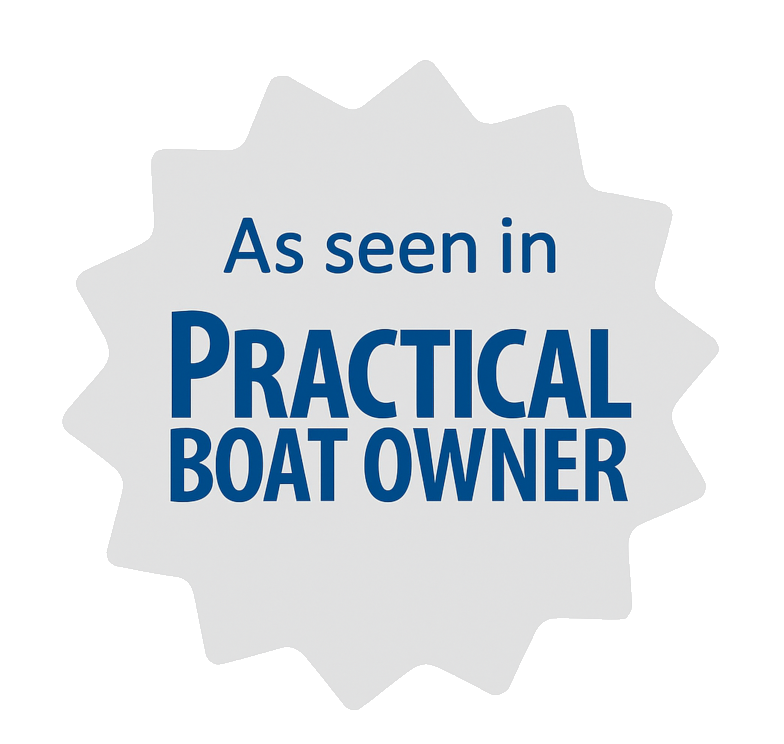Build a Central Marine Computer with Raspberry Pi: Monitor and Protect Your Boat
Transforming your boat’s monitoring and alert systems doesn’t require proprietary hardware or expensive marine computers. With a Raspberry Pi, a few affordable sensors, and free open-source software, you can build a reliable, expandable central marine computer that integrates navigation data, engine monitoring, solar power stats, tank levels, and even security features — all on a budget.
Whether you’re sailing offshore or tied up in a marina, your boat’s key systems can now be monitored, logged, and alerted directly to your phone or tablet.
Using one ESP32 microcontroller, you can wirelessly send multiple engine parameters to your marine computer:
All NMEA data from your boat’s instruments is integrated and displayed in custom dashboards. This includes (but is not limited to):
Fuel, water, grey water — all resistance-based tank sensors can be digitized using INA219 modules. Add state-of-charge and solar production monitoring with Victron BLE or shunt integrations.
Wireless water sensors detect leaks near seacocks or bilge and trigger sirens or remote alerts.
Easily control various onboard systems with intuitive virtual switches:
Geofence-style anchor alarms without extra apps. It can trigger onboard sirens and send push alerts to your phone when dragging is detected.
Wireless smoke detectors and indoor sirens allow you to detect fire, and notify crew or nearby vessels.
Monitor or control your systems from land. Turn on the bilge pump from your phone if your float switch fails — even when you’re away.
These are the components for the core system that ties everything together:
These low-cost add-ons enable specific monitoring functions:
This system runs Home Assistant, a powerful open-source automation hub that is:
Follow the full 26-part video series to build your marine computer step-by-step:
 Smart Boat Innovations YouTube Playlist
Smart Boat Innovations YouTube Playlist
This base setup includes everything you need to build a robust, expandable marine monitoring solution. New sensors or devices can be added anytime without changing the core.
 Visit smartboatinnovations.com to get started.
Visit smartboatinnovations.com to get started.
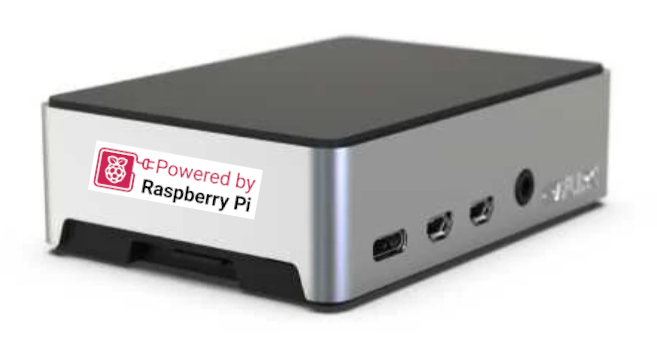
Why a Central Marine Computer?
A well-designed marine computer consolidates all essential boat data into one interface. The benefits are immediate and powerful:- Real-time alerts for temperature, bilge water, battery state, and more
- Customizable automations (e.g., turn on anchor light at sunset and off at sunrise, but only if the boat is stationary)
- Access to engine diagnostics and trend analysis
- Monitoring from anywhere, using tablets or phones
- Full support for NMEA 0183 and NMEA 2000, wired and wireless
- Display of all NMEA instrument data on custom dashboards
- Local, secure, and cloud-free solution

Core System Features
Below is a non-exhaustive list of what your system can do using real examples from the Smart Boat Innovations project: Engine Monitoring
Engine Monitoring
Using one ESP32 microcontroller, you can wirelessly send multiple engine parameters to your marine computer:
- Coolant temp
- Thermostat temp
- Raw water elbow temp
- Alternator temp
- Oil pressure
- Tachometer (RPM)
- Fuel level
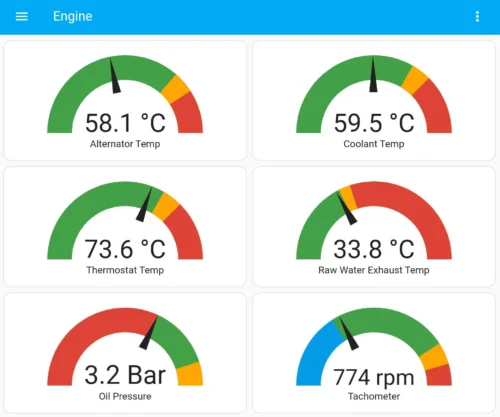
 NMEA Instrumentation
NMEA Instrumentation
All NMEA data from your boat’s instruments is integrated and displayed in custom dashboards. This includes (but is not limited to):
- Depth
- Wind speed/direction
- GPS location
- Compass/heading
- Water temperature
- Boat speed

 Tank Level and Battery Monitoring
Tank Level and Battery Monitoring
Fuel, water, grey water — all resistance-based tank sensors can be digitized using INA219 modules. Add state-of-charge and solar production monitoring with Victron BLE or shunt integrations.
 Bilge and Leak Detection
Bilge and Leak Detection
Wireless water sensors detect leaks near seacocks or bilge and trigger sirens or remote alerts.
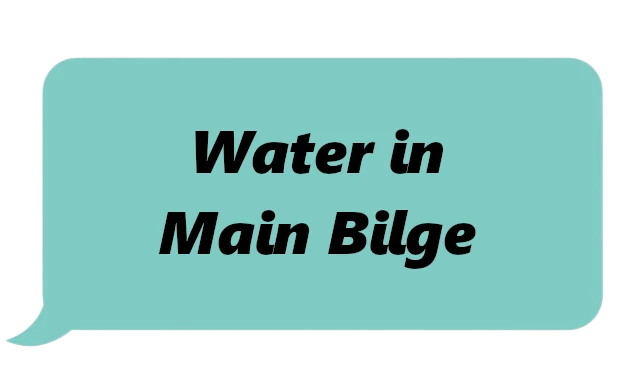
 Virtual Switches
Virtual Switches
Easily control various onboard systems with intuitive virtual switches:
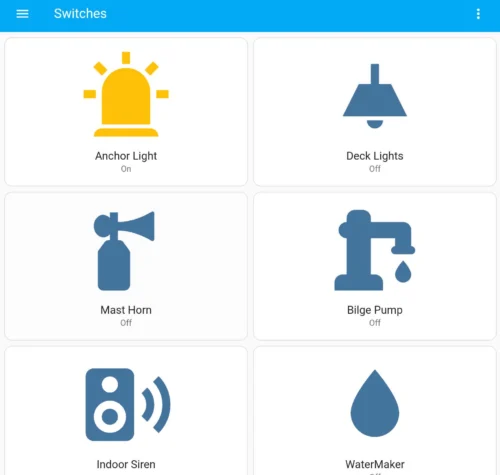
 Anchor Alarm and GPS Tracking
Anchor Alarm and GPS Tracking
Geofence-style anchor alarms without extra apps. It can trigger onboard sirens and send push alerts to your phone when dragging is detected.
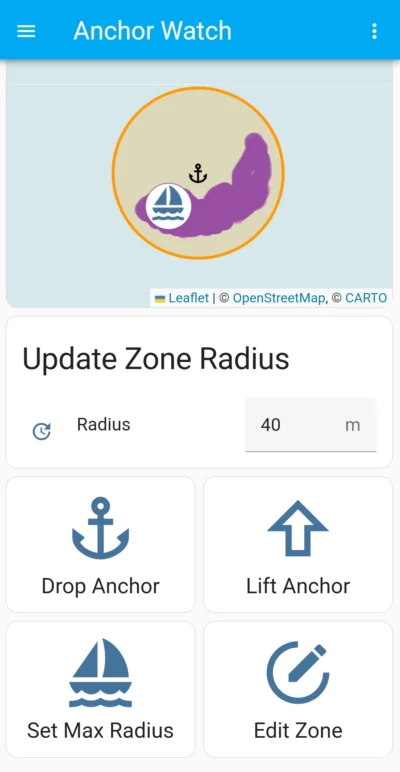
 Smart Automations
Smart Automations
- Auto anchor light on at sunset/off at sunrise (only if the boat is stationary)
- Use excess Solar power when batteries are full
- Fans or blowers activate at engine over-temp
- Watermaker routine flush daily
- Custom alerts like “Wind speed limit exceeded or Boat off course”
 Fire, Intruder & Siren Alerts
Fire, Intruder & Siren Alerts
Wireless smoke detectors and indoor sirens allow you to detect fire, and notify crew or nearby vessels.

 Remote Access and Control
Remote Access and Control
Monitor or control your systems from land. Turn on the bilge pump from your phone if your float switch fails — even when you’re away.
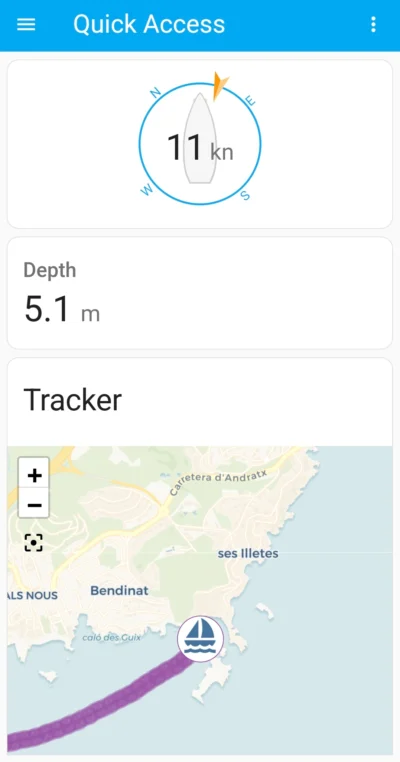
NMEA Compatibility
This is key. Your setup supports:- NMEA 0183 over USB or Wi-Fi
- NMEA 2000 via USB or wireless via ESP32
 Required Core Equipment – Central Marine Computer
Required Core Equipment – Central Marine Computer
These are the components for the core system that ties everything together:
- Raspberry Pi 4 or 5 (4GB+ RAM)
- A2-rated 32GB+ MicroSD card
- 12V to USB-C converter (regulated power)
- 4G router with external SIM (e.g., TP-Link MR6400)
- Zigbee USB dongle (Sonoff Zigbee 3.0 or equivalent)
- USB-to-Serial converter for NMEA 0183
- USB-CAN adapter for NMEA 2000
 Optional Sensor Modules – For Expansion Projects
Optional Sensor Modules – For Expansion Projects
These low-cost add-ons enable specific monitoring functions:
 Engine Monitoring
Engine Monitoring
- ESP32 microcontroller
- DS18B20 sensors (Coolant, thermostat, alternator, elbow)
- INA219 sensors (Oil pressure, fuel level)
- Optocoupler (Alternator pulse-based RPM sensing)
 Energy & Solar
Energy & Solar
- Victron BLE integration (for MPPT solar controllers)
- Hall current Sensors
 Tank & Fluid Monitoring
Tank & Fluid Monitoring
- Resistive tank senders (fuel, water, grey water)
- INA219 voltage mapping for analog sensors
 Safety & Security
Safety & Security
- Zigbee water leak sensors
- Wireless indoor sirens
- Smoke detectors (Zigbee)
 Automation Hardware
Automation Hardware
- Relay switches (for watermaker, horn, lights)
- Magnetic chain sensor (for anchor winch chain measurement)
 Software Overview
Software Overview
This system runs Home Assistant, a powerful open-source automation hub that is:
- Free
- Customizable
- Locally controlled (no cloud dependencies)
- Accessible via smartphone, tablet, or web browser
 Step-by-Step Video Series
Step-by-Step Video Series
Follow the full 26-part video series to build your marine computer step-by-step:
 Smart Boat Innovations YouTube Playlist
Smart Boat Innovations YouTube Playlist
 Total Cost: Approx. $400
Total Cost: Approx. $400
This base setup includes everything you need to build a robust, expandable marine monitoring solution. New sensors or devices can be added anytime without changing the core.
Conclusion
A DIY central marine computer using a Raspberry Pi gives you:- Full situational awareness
- Data-driven decision making
- Proactive safety and maintenance alerts
- Peace of mind — even when away from your boat
 Visit smartboatinnovations.com to get started.
Visit smartboatinnovations.com to get started.
⚠️ Disclaimer
The information provided is for educational and informational purposes only. Perform all installations safely and correctly; consult a licensed professional for boat electrical work. Use at your own risk.
Tagged bilge alert system, boat alert system, boat automation, boat monitoring system, boat remote monitoring, central marine computer, DIY boat electronics, engine monitoring, ESP32 marine, Home Assistant marine, marine computer, marine instrumentation, NMEA 0183, NMEA 2000, open plotter, raspberry pi boat computer, signalk, smart boat sensors, solar monitoring boat, tank level monitoring, zigbee boat sensors

